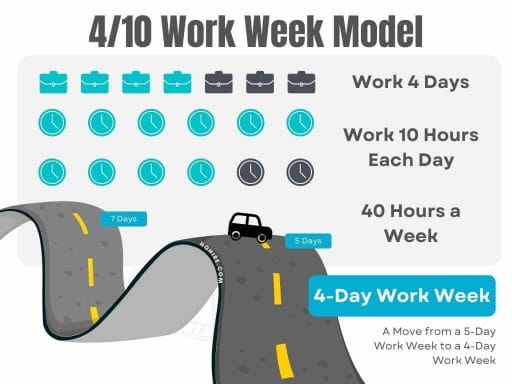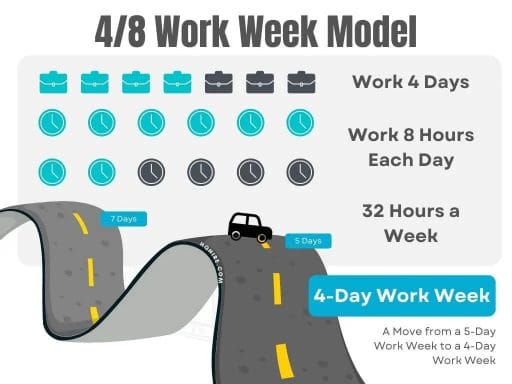As employees are gaining more flexibility at work, such as hybrid work, and remote work, the 4-day work week is also gaining popularity.
A 4-day work week has many advantages over the traditional 5-day work week, such as better mental health for employees, and a lower turnover rate for the company.
However, while there are noted benefits, there are also significant disadvantages that need to be considered of having a 4-day work week arrangement.
What Are The Disadvantages of a 4-Day Work Week?
“The main disadvantage to a four-day workweek is that it can be more difficult to get the same amount of work done in the week.”
Reducing the work days from a 5-day work week to a 4-day work week will mean either working longers hours each day, or improving work efficiency in order to produce the same result and get the same work done.
Cons to working a 4-day work week include poor customer satisfaction, increased stress levels, lower productivity, and poor health outcomes. However, these disadvantages can be overcome with creative thinking and innovative management.
In the rest of this article, we discuss the main reasons why working a 4-day week might be a disadvantage for your workplace and what are some ways that you can overcome these difficulties.
1. Adopting the wrong 4-day work week model
Two different models of a four-day work week are gaining popularity.
- 4/10 Work Week Model
- 4/8 Work Week Model
Each work model has its own pros and cons, choosing to adopt the wrong model can lead to reductions in work productivity and even loss of customers, depending on which industry you are in, different companies should adopt a different four-day work week model.
4/10 Work Week Model (Compress five days into four per week)
With the 4/10 work week model, employees would be expected to maintain a 38-40 hour work week in just four days by working longer hours each day.

While this might be beneficial for some employees, such as having one extra day to rest. The longer hours each day can lead to the employees experiencing stress and fatigue. Which can lead to lower productivity at work.
4/8 Work Week Model (Reduce the total number of work hours per week)
With the 4/8 work week model, employees will work 30-32 hours work week for four days by working more efficiently each day.

This is the most common and widely preferred method because it retains the standard 7-8 hour work day with 1 less work day each week. But as fewer hours of work are performed each week, this may not be suitable for a certain industry.
What should the employer do when adopting a 4-day work week?
Companies should assess which 4-day work week model will suit their business needs.
- 4/10 Work Week Model: 4 Days of work, 10 hours per day.
- 4/8 Work Week Model: 4 Days of work, 8 hours per day.
While implementing the new work arrangements, employees need to understand that to get the full social, emotional, and physical benefits of a 4-day work week, they need to ensure all required work can be completed with the new work arrangement and results should be delivered.
The change from a traditional 5-day work week should be beneficial to both the employees and the employer and not at the cost of the overall well-being of the company or the employee.
2. Poor customer satisfaction
For companies that are in the service industry, customer satisfaction is probably the most important. It doesn’t matter whether productivity and workplace satisfaction is up, if the customer is not satisfied with the service, then they will be less likely to pay money for it or recommend it to their friends and family.
If companies are not able to satisfy their customer due to having fewer workdays can be at a disadvantage. Potential customers might switch their allegiance to a company open for the full five days each week.
How do you ensure customers’ needs are attended to when adopting the 4-day work week work arrangement?
The best solution is to implement a roster so that service staff is always available to provide the necessary products and services to the customers.
By applying the right 4-day work week model, together with a perfectly planned rostering, the company should have no issue opening for business 5 or even 7 days a week, while allowing its employee to enjoy the benefit of a 4-day work week.
3. Increased stress
According to the American Institute of Stress, the pressures of the workplace are the leading causes of stress for American adults.
This includes the following statistics about workers:
- 40% say their jobs were very or extremely stressful
- 25% see their jobs as the most stressful part of their lives
- 29% feel quite a bit or extremely stressed at work
- 80% feel stress on the job
- 50% feel like they could benefit from managing stressful workplace situations
If you adopt the 4/10 work week model for the 4-day week work arrangements, you will be expected to work the full 38-40 hours in a contracted timeframe.
This means that you might end up working shifts up to 10 hours each day. This is an advantage for some people but for others, the longer hours might make a stressful situation even worse.
What should employers do to reduce stress at work?
Employers may want to adopt the 4/8 work week model, where employees do not have to increase the number of hours they work each day.
4. Longer daily working hours
If your workplace chooses to implement a 4-day work week but adopts a 4/10 work week model, employees will have to work longer hours each day to achieve their normal 38-40 hours of work each week.
When one such pilot program was adopted in Utah in 2008 as a budget-saving measure, employees experienced significant difficulties such as:
- Missing important activities with their children such as after-school sports and performances.
- Struggling to find daycare centers that opened for longer hours.
- Maintaining concentration while working longer hours, especially in sedentary jobs in front of the computer.
Not wanting to work longer daily hours each day?
Employers may want to explore ways to improve the work effectiveness so they can do 5-day worth of work in just 4-days and adopt the 4/8 work week model.
Not only this will allow employees to maintain the normal 7-8 hours of work each day, but work can also be streamlined and become more efficient.
5. Loss of productivity
While some studies show that working a 4-day week can increase workplace productivity, in some circumstances it can have the opposite effect.
For example, working just four days each week might lead some employees to complacency due to the loss of a fundamental full-time work ethic. Essentially, some bad workers might take the new work arrangement for granted and become feel less committed to the job, investing less energy to help the company succeed.
How do you prevent the loss of productivity at work?
When employers implement a 4-day work week, they need to monitor workplace attitudes over a period of time to understand whether employees are experiencing adverse effects.
This includes reviewing levels of productivity and job satisfaction.
6. Poor health outcomes
According to the World Health Organization, when you work longer hours, you’re more likely to be diagnosed with or suffer from:
- Stress
- Migraines
- Stroke
- Ischemic heart disease
- Obesity
- Repetitive stress injuries
If you are adopting the 4/10 work week model, employees will be working the same number of hours every week, compressing them into fewer days which can put more stress on the body with detrimental health effects.
Preventing poor health outcomes when adopting a 4-day work week?
Employers may want to consider adopting the 4/8 work week model by working more effectively over the 4/10 work week model.
With employees working the normal 7-8 hours each day, employees will have a reasonable amount of time to rest each day.
7. Less time to get things done
When you are changing from a 5-day work week to a 4-day work week, employees will often have less time to complete the same amount of work.
This means that employees will need to work at optimum productivity for most of their working day to achieve their targets.
Employees might actually experience raised stress levels to achieve their goals in less time than they are used to. And if these stress levels are maintained, overall productivity will be reduced.
How to get the same amount of work done in less time?
Employers can deep dive into the business operations and identify areas where improvement can be done to improve the work effectiveness of each worker.
There are many tools and methodologies that can improve the efficiency of a process.
Types of improvement methodology:
- Lean manufacturing. The systemic process to minimize waste and improve productivity.
- Six Sigma. The data-driven process to reduce defects and improve performance
- Agile Methodology. Do it now, improve as we go approach, improvement is a continuous process at every stage.
- Just-in-time. An inventory management methodology where process where goods are produced only when needed, a process to eliminate inventory cost.
- Theory of Constraints. A systematic improvement to remove limiting factors in a process that prevent the achievement of goals.
By utilizing the right tools, companies can improve their work effectiveness and get more work done in less time.
Even with a 4-day work week, employees can achieve or exceed their goals with less time.
8. Loss of income
Implementation of the 4-day work week can lead to a loss of income for some employees.
According to the United States Department of Labor, unless you are protected by an employment contract, your employer can legally reduce your hours and income as long as they provide you with appropriate notice and your income does not fall below the Federal minimum wage.
What should you do before agreeing to a 4-day work week?
Before agreeing to a 4-day work week, you should understand what are the possible changes in the benefits, compensation, and work arrangements.
- Will you get a pay cut?
- Will your current company benefits get taken away?
- What is the change in the compensation you’ll get?
- Will the 4-day work week means working fewer hours per week, or working longer hours each day?
- What are the other options available to you?
Often a change in a work arrangement will require an employee to sign a new contract of employment to agree to the new changes.
Signing the new contract of employment will mean you’ve agreed to the terms and conditions, thus it is advisable to look it through and understand the employment contract before you sign.
If there is an employment bond in place, resigning from the job with a bond will be difficult.
9. Scheduling conflicts
If your company offers a 4-day working week but stays open for the full five days or even seven days a week, management will have to schedule staff members to cover their colleagues when they are not working.
With a 4-day work week, scheduling of staff can become harder as each staff will be working one less day a week, which means better planning will be required.
How do you prevent scheduling conflicts?
Allow employees to nominate the days they choose to work. If necessary, implement a rotating schedule so that it is fair for everyone and that there are no staff shortages.
There are many scheduling Softwares available that can help in improving business productivity and efficiency
- Calendly
- Appointy
- HomeBase
Or you can simply create a work schedule using Microsoft Excel. Microsoft Excel is an excellent tool that can help you create an engaging and clear work schedule at work with little to no cost. And if you want to learn how to make one, check out these best online Excel courses with professional certifications.
10. Loss of entitlements
Switching to a 4-day work week could affect your holiday entitlements or even your status as a full-time employee.
While the U.S. Department of labor‘s Fair Labor Standard Act (FLSA) does not define what is considered full-time employment or part-time employment. Most companies currently identify any employee who works an average of 32 to 40 hours a week or 130 hours a month as a full-time employee.
Understand what it means to switch to a 4-day work week.
Seek clarification and understanding from your employer and HR to ensure that all contracts and workplace agreements do not financially penalize employees who switch to a 4-day week, nor do the new work arrangement cause employees to lose their holiday pay or benefits.
Why it Might Be Difficult to Adopt a 4-day work week?
Adopting a 4-day work week is not easy, and it is important for business owners to understand that each company should have slight variation in its 4-day work week work model.
Depending on the company’s capacity, resources, and needs, the company should adopt a wholly modified model in order to gain the benefits of having a 4-day work week.
Things to consider:
- Type of industry of the business.
- Availability of technology that allows elimination of non-value-added tasks.
- Availability of technology that allows improvement of work efficiency.
- Dedicated project management team to help make the change from a 5-day work week to a 4-day work week.
- Workplace planning allows the transition to be seamless and eliminates the possible disruption of the company’s operation.
- Capability for sound and timely communication.
Currently, many businesses do not have the capability and resources to implement a 4-day work week.
But as more companies start to evolve and adapt to the new work arrangements, the 4-day work week model will get refined and more companies can allow their people to work 4-days without losing their competitiveness in the market.
Which industry should adopt the 4-day work week?
Industries that rely on knowledge workers are well equipped to move to a compressed schedule by improving the work efficiency or working longer hours each day.
Industries that provide a service are less able to make the switch as 1 less work day will often lead to a lower level of productivity which can impact the company’s operation.
However, these disadvantages can be overcome by making some slight changes to the 4-day work week model.
- Implementing a rotating staff schedule
- Staggered work days schedule
By making simple changes to the work arrangements, even services like healthcare (Doctors and nurses), first responders (Emergency Medical Technicians (EMTs), paramedics, firefighters, and police officers), and tech support could adopt a 4-day work week.
Read Also:
- How to Become a Remote Developer: Your Complete Guide to a Digital Nomad Career
- How to Become a Blockchain Developer: Complete Guide to a Career in Blockchain Technology
- How to Become a SQL Developer: Complete Guide to a Career in Database Development
- How to Become a Freelance Travel Writer (Step-by-Step Guide)
- How to Become a Remote Freelance Technical Writer (Step Guide)
Join over 11,000+ achievers who are committed to achieving their career goals!






